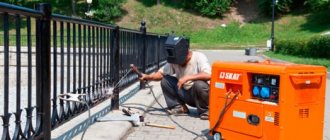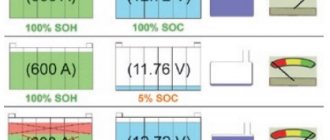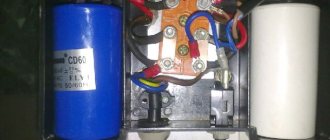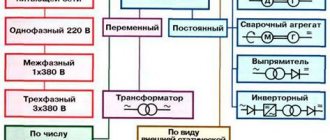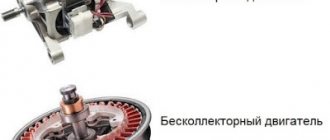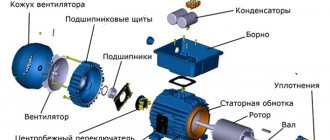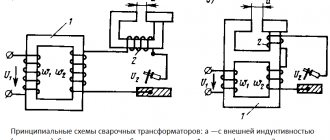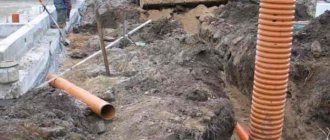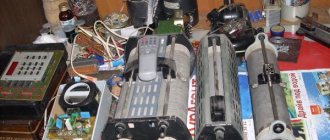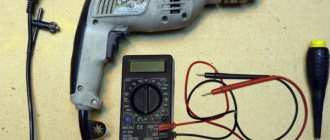UPD: Connecting the boiler to the generator.
Often a generator is purchased to be used in winter to power the heating system boiler. There are some peculiarities here.
For imported phase-dependent boilers, it is important that the power system has a solidly grounded neutral, i.e. neutral and ground are connected together, and when connecting, the polarity is observed (phase-zero)
In the case of a portable generator, which is discussed in the article, there is neither zero nor phase. They must be made artificially - one output of the generator will be a phase (L2), and the second (N2) will be placed on the ground, i.e. ground.
In addition, as is known, boilers are very sensitive to the voltage form. And at the output of a conventional generator, the sine wave is “dirty”; if necessary, I will take an oscillogram. First of all, this happens because... The alternator that generates electricity is brushed, and because of the brushes sparking, failures, and similar unpleasant things occur.
It is because of this that Off-line and Smart UPS are not suitable for boilers. There at the output there is a quasi-sine with a bunch of harmonics, the oscillograms can be viewed here. And for boilers, Online UPS (double conversion uninterruptible power supplies) is used. For such a UPS, the shape, magnitude and frequency of the input voltage are not particularly important, because it cooks a constant voltage from all this mess, from which it then electronically receives a pure sine wave. And if the boiler is powered through such a UPS, then you can use a regular generator for its backup power.
For boilers and other sensitive equipment, it is recommended to use inverter generators - this is a generator plus an online UPS. The inverter generator includes a regular generator, which is controlled by a controller, and an inverter, which produces pure sine wave - what boilers need.
Connection diagrams
Having dealt with the auxiliary issues, they proceed directly to connecting the generator to the service line.
Connection via an additional distribution machine
The circuit diagram for connecting the machines from the line and the generator is almost the same, which allows you to not change anything in the existing three-phase electrical network. This approach to connecting a private home to the network is the most reliable and guarantees the successful operation of the equipment connected to it. To implement it, you will need to perform the following operations:
- Turn off the 380 Volt input circuit breaker by de-energizing the home network.
- Install a new 4-pole circuit breaker in the panel, the output terminals of which are connected by sections of conductors to the input contacts of all linear devices.
- The cable from the generator output with 4 cores (3 phases and zero) is fed to the new machine and each of them is connected to the corresponding terminal.
If an RCD is installed further in the diagram, when making switching, the wiring of the conductors connected to it (each of the 3 phases and zero) is taken into account.
Connection via switch
A changeover switch is the same switch, but has three positions. When using it, the busbars from the generating device are connected to one set of poles, and the supply wires from the high-voltage line are connected to another. The central contact set of the switch, the conductors from which go directly to the load, is alternately thrown towards the input from the explosive or to the generator supply. In the middle position of the switch, the entire home network is completely de-energized.
Automatic switching circuit
It is possible to get rid of the need to manually select a power source by using an automatic switching circuit for the load connected to it. At a minimum, it includes a control module and two cross-connected starters (contactors). The first of these nodes, manufactured on the basis of a microprocessor, semiconductor transistors or analog microcircuits, performs the following functions:
- recognition of a situation with a loss of electricity in the main supply line;
- subsequent disconnection of the consumer from it;
- switching it to a tap from a 3-phase generator.
Through a socket
To connect the generator to the home network through an outlet, you will need to carefully familiarize yourself with the features of using this method. Despite its simplicity and ease of connection, this option has many negative aspects, expressed as follows:
- the need to constantly ensure that the introductory machine is turned off;
- the need to purchase a special 4-pole socket designed for high currents;
- restrictions on the load connected to the generator.
The plug-in method is the worst of all possible. Its use is unacceptable under any conditions.
{SOURCE}
How can you not do it?
The first thing you should talk about is how it is prohibited to connect the generator to your home network. Some would-be electricians advise connecting the power station to the nearest outlet in the house, having first turned off the circuit breakers on the input panel. Do not do this under any circumstances, because the power of the generator can significantly exceed the capacity of the outlet (as a rule, it can withstand no more than 3.5 kW). The result is exceeding the maximum load, short circuit, fire. In addition, if you forget to turn off the input circuit breakers, then when electricity is supplied to the network, the backup station will instantly fail.
We advise you to study - Types and types of sockets: from classic designs to modern multifunctional models
The only way to get by without proper connection is to connect an extension cord to the power station and plug in the electrical appliances you need. Only if your backup station is low-power (up to 4 kW) is it allowed to connect it through an outlet. To do everything correctly, be sure to watch the video below.
Correctly connecting equipment to the outlet
However, if you often have power outages at your dacha or at home, we recommend connecting the generator to the network through a changeover switch or an autostart system - AVR. Below we will talk about how to do it correctly with your own hands.
Minimum required to connect a generator
However, not much is needed to technically correctly connect the generator to the home electrical network. First of all, provide a separate input. It is recommended to use a high-section copper cable (at least 4 mm2) and lay it from the input distribution device to a specially equipped generator installation site.
You will also need a changeover switch. For domestic needs, many options for such devices have recently appeared in a modular design for mounting on a 35 mm DIN rail. Off the top of my head, you can offer a whole range of devices. From the cheapest products of the TDM-63 brand to more high-quality and reliable devices of the E200 series from ABB or SFB from Hager.
The devices have the simplest connection circuit and operating principle. As a rule, the common bus of outgoing loads is connected to the lower contacts. On the reverse side, where the contacts are paired, two separate inputs are connected. The switch key has three positions; on average, all circuits are open. In almost all series, the devices can be multi-pole, which will greatly facilitate work with a three-phase network and a complex grounding/zeroing system.
It is important to remember that a three-position (changeover) switch operates on the principle of a load switch; it does not have either a thermal or electromagnetic release. Therefore, each input must be additionally protected by an automatic circuit breaker, the current limit of which is determined by the permissible load on the supply line
The simplest changeover device can be made by yourself from a pair of two-pole circuit breakers from the same manufacturer. They need to be placed side by side, one turned upside down, and then the keys connected together by inserting a steel pin into the standard hole.
Scheme
Correct connection of a diesel or gasoline (gasoline generator) backup power source involves the use of additional circuits and configurations. The diagram must be drawn up correctly and efficiently, so it is better to entrust this procedure to a professional. Here all the subtleties of the home network are taken into account and permissible loads are determined. Some consumers prefer 2-3 kW installations, which are sufficient to operate for several hours after a failure. The connection diagram for a gas generator may look very simple. The main thing is that it is compiled correctly , and it ensures proper load indicators.
As mentioned above , without the proper skills or experience, there is no point in creating connection diagrams yourself. This may not lead to the most pleasant consequences, because... It is difficult for an inexperienced consumer to correctly draw up a diagram and apply it in action. Instead, it would be wise to consult with an experienced electrician and have him do the job.
Read also: Do-it-yourself chainsaw sawmill, photo drawings
AUTOMATIC DIAGRAM FOR CONNECTING THE GENERATOR TO THE NETWORK
This type of connection is strongly recommended by experts, since it is not only very reliable, but also provides the necessary comfort.
For those who know electrical engineering at a professional level, this method is better than all others. It involves the installation and use of an automatic transfer switchboard (ATS). As soon as the centralized power supply is turned off, the controller or relay of the ATS unit will start an autonomous source without human intervention and after some time transfer the load to it (Fig. 2).
If you understand that your qualifications are not high enough, then you should limit yourself to the stage of connecting the ATS unit, and involve a specialized organization in the assembly of this shield. This will protect the house from incorrect circuit solutions. For example, the absence of a mechanical interlock for the simultaneous activation of a pair of contactors can lead to parallel operation of the generator and the network, the consequences of which will be disastrous for both the equipment and the building.
Mini-power plants equipped with an electric starter, which, upon receiving a signal from the ATS, will start the generator, have the ability to connect via an automatic transfer switch. If the purchased model of an autonomous source is designed only for manual start-up mode, then the AVR. of course, will switch the consumer circuit to an autonomous source and back when the centralized power supply is restored. But you will have to turn the generator on and off manually. In this situation, it is more advisable to limit yourself to connecting the generator through a three-position switch-disconnector.
How to make a simple auto-switching circuit for a generator
It is inconvenient to always press the switch when starting a backup unit, so a simple automatic switching unit is assembled. This is not an autostart system; its task is to mechanically change the input between networks - the mainline and the mini-station. Starting/stopping the engine still needs to be done manually.
- 2 starters (contactors) - KM1 and 2 with cross connection. Their executive elements are contacts: power (KMk), normally closed (KMnz);
- For full automation it is necessary to install a time relay for warming up.
Installation of an AVR unit with automatic start of a gas generator
In light of the above, a device that generally eliminates human intervention in the operation of the emergency power supply system would be very useful. There really are such devices and they work completely uninterrupted, but only with generators equipped with an electric starter and a standard stopping system.
Developing such a system on your own is a troublesome task, worthy of separate discussion. If the work is not organized correctly, there is a high risk of damaging the equipment. For example, if the generator has a breakdown in the motor part, its forced repeated starting will cause, at the very least, a deep discharge of the battery, and in the worst case, will lead to failure of the electric starter windings.
There are two options for such devices, the first is a standard electronic control unit, supplied with the generator and installed with it in the same room. Such a unit is connected according to the diagram included in the instructions and it only controls starting and stopping the engine, in some cases it takes on the task of adjusting the speed and output power. The main switching of the reserve input is performed by contactors according to the scheme that we described earlier. Only in this case, a normally open contact on the main input is extended with a low-current signal wire to the control unit so that the current state of the city line makes it clear to the electronics when the generator should be started or stopped.
1 - automatic generator start block; 2 — main input contactor; 3 - backup input contactor
The second option is complete ATS devices with autostart. This is not a very wide range of devices, but they all require the installation of additional equipment on the generator: an electric throttle drive and a starter with a battery.
Connecting the generator via an automatic transfer switch: 1 - input circuit breaker; 2 - counter; 3 — AVR shield; 4 - generator; 5 - control cable; 6 - zero bus; 7 — consumer machines; 8 - ground bus
The advantage of such systems is that they have everything you need out of the box and completely replace the input distribution device, including built-in current protection, and sometimes even have a surge and leakage protection system. All you need to connect is to connect the input cores and consumer buses to the switching devices, and also connect the secondary terminal block to additional generator equipment using a four- or five-core wire.
Schemes for connecting via an outlet to a home network
There are several key methods for connecting generators through an outlet.
- Connecting a backup power source to a dedicated group of consumers according to a separate, pre-created circuit;
- Using a changeover switch or a three-position switch, where jumpers are made at the input from the generator side. This method will allow you to properly power your entire home network. The main disadvantage of the design is the impossibility of using three-phase generators;
- The use of two contactors, where one acts as an adapter from the city network, and the other serves as a bridge from the backup source. The method is in great demand when using autostart systems. When choosing it, you need to take care of the jumpers between the inputs on the reserve side;
When connecting a three-phase installation to a three-phase network, you must first equip the appropriate electrical receivers, for example, motors of electrical machines.
When installing a backup power source in a country house or country house, you must correctly assess your capabilities and be responsible in choosing the appropriate solution. In this case, the purchase will meet all your expectations and become productive.
Difference between single and three phase connection
All connections, whether in a single-phase or a three-phase network, are made completely identical, with the exception of the number of power wires. The only important nuance concerns the so-called control phase - if you connect the starter to the network, then its main contacts connect and disconnect the power wires from the network, and the power for the electromagnetic coil must also be taken from somewhere.
In a single-phase network there are no problems - there is only one phase and such a question simply does not exist, but in a three-phase network everything is somewhat more complicated - there are L1, L2 and L3. Without going into technical details, there is only one answer - for control circuits you can use any of the phases, but only one. That is, if the KM1 coil is powered from phase L3, then the control of the remaining starters, the “Start” and “Stop” buttons must also be “hung” only on it. This is not difficult to do - just note what color the wire is on the desired phase, and if the cable has single-color conductors, then stick or draw markers on them.
We do not recommend:
- Ground one of the generator outputs to the common house PE bus (ground). If your ground “falls off” (a wire rots or a connection comes loose), dangerous voltage will appear on all grounded appliances in your home.
- Connect budget generators directly to the load without using network interference filters. Changing the generator speed causes strong interference and voltage surges, which are dangerous for sensitive electronic equipment (automatic gas boilers, expensive household appliances).
- Use three-phase generators with a power of up to 10 kW for backup power at home. Phase imbalance will lead to rapid failure of the generator. Use single-phase generators with a phase combination circuit.
- Connect inverter generators to a common neutral bus. This can lead to rapid generator failure.
- Neglect the rule of grounding the generator housing itself.
- Use a non-inverter generator without a solidly grounded neutral of one of its outputs, because this leads to incorrect operation of differential protection devices (RCDs) and errors in the operation of phase-dependent boilers.
- Use the generator output for grounding, which is turned off by a single-pole circuit breaker on its body.
We’ll talk about how to properly connect a generator to the network (220/380V) of a country house later.
Types of generators
Gasoline generator DDE GG3300P
Based on the type of fuel used in the unit, all known generating devices can be:
- gasoline;
- diesel;
- units running on gas or wood.
The first two options attract the attention of users who have taken as a basis a ready-made engine running on gasoline or diesel fuel. According to their purpose, known samples of three-phase current generators are divided into main and backup units
The question of how to connect to a household network concerns both models
According to their purpose, known samples of three-phase current generators are divided into main and backup units. The question of how to connect to a household network concerns both models.
Choice
The buyer must determine from the very beginning which technical parameters are the most important for him. It is worth taking a closer look at these indicators:
- Weight.
- Dimensions.
- Power.
- Fuel consumption.
- Noise level.
- Duration of work.
Automation and price are parameters that are also being looked at
This is important for those who are interested in how to connect a generator to the home network, the diagram of which is posted on specialized websites
Generator operation
By parameters
Many people first look for an answer to the question of how many phases a generator should have for maximum convenient operation. To do this, you need to understand what electrical appliances will be connected. Three-phase options allow connection to both single- and three-phase devices. Single-phase ones are combined with only one type of consumer. But this does not mean that models with more phases will be better under all circumstances.
At each phase, the maximum load should be no more than 30%. This means that in reality the owners will not be able to use more than a third of the rated power that the outlet initially has. For example, the rated power of a three-phase generator is 6 kW. This means that no more than 2 kW can be removed from a regular 220 V outlet. The load still needs to be distributed over several phases when connecting a single-phase generator to a three-phase network at home.
Note! For power, they also check the parameters of the devices that are planned to be connected
It is important to have a reserve of at least 20-30%. Otherwise, you may encounter problems such as overload and work stoppage. Too much fuel will also be consumed
Too much fuel will also be consumed
Otherwise, you may encounter problems such as overload and work stoppage. Too much fuel will also be consumed.
Type
Synchronous and asynchronous types of devices are available. The choice involves a careful study of the characteristics of each of the existing models.
Asynchronous
Their main problem is their inability to handle so-called peak loads. Although these devices can also be used to maintain normal voltage readings. They are suitable for joint use with equipment sensitive to voltage surges:
- Electronic devices.
- Computer Engineering.
- Medical devices supporting gasoline generators.
Residual magnetization of the rotor is the main source of energy for such devices. Therefore, the service life of asynchronous generators is longer than that of their closest analogues. They do not require the use of cooling systems; the unit housing is completely closed. Thanks to this, protection from dust and moisture is fully guaranteed.
Interesting! The asynchronous generator is immune to short circuits. Therefore, this energy source is the optimal solution for welding machines. But such devices can be very sensitive to overloads. Therefore, it is prohibited to connect them to devices with initially high inrush currents.
Synchronous
The quality of the current in this case is lower when compared with the previous option. Suitable for providing emergency power in various circumstances:
- Offices.
- Refrigeration units.
- Electrical equipment in dachas and country houses.
- Construction projects.
Such devices also have some positive qualities:
- Resistance to short-term overloads.
- Ability to normally withstand peak loads, including mechanical loads.
But protection from moisture, dust and dirt is worse than that of asynchronous structures. After all, in order to cool, such generators need to pass a certain amount of air through themselves. A synchronous generator will be needed if devices operating with reactive loads are used. Then the power will be less.
Changeover switches
Phasing
It has already been mentioned above. It is worth buying three-phase generators only if there is a consumer with the appropriate characteristics in the house. If all the devices are single-phase, then the generator is selected of this type. This even applies to situations where there is a three-phase network connected to the house.
Network connection
Selection of electric generator
A home power plant consists of an internal combustion engine and a rotating generator that produces electricity. The most common are four-stroke models with a maximum speed of 3 thousand revolutions. The volume of the fuel tank in domestic models is 10-15 liters. The main selection criterion should be the area of use. Generators can act as the main source of energy, but more often they are a reserve in an emergency.
When choosing, you should pay attention to some parameters:
- motor resource;
- power;
- efficiency;
- convenience.
When connecting, it is important to ensure the coordinated operation of 3 elements:
- home network - consumer;
- centralized supply chain;
- cable from the reserve.
Before connecting, determine the following points:
- safe and economical location of the electric generator;
- frequency of power failures in the general network, need for automation;
- calculated power consumption taking into account reserve and losses.
A suitable connection diagram must be provided.
A continuous supply of energy is quite expensive; a private home rarely needs such provision. Important consumers of electricity, such as a computer, can be connected to an uninterruptible power supply.
First of all, it is necessary to calculate the power of energy consumed. It is the sum of the load capacities that are planned to be connected. Additionally, a margin of 30% of the total value is added. This is required to take into account the starting currents of motors of household appliances, which are 2-3 times higher than permissible. You can select a unit based on its estimated power.
Calculation example. The house has a washing machine 2 kW, refrigerator – 0.5 kW, electric stove – 3 kW, general lighting – 0.5 kW, TV and computer – 0.5 kW. The total power is 6.5 kW, but when taking into account the reserve, the calculated value will increase to 8.5 kW.
The connection diagram for a gasoline generator to the home network should be as simple as possible. The main thing is that it is correct and allows the unit to be provided with the required load.
Errors when connecting backup power
You cannot connect portable power stations if the machine in the input panel is turned off. Unfortunately, many people do this without realizing that such a step can lead to a short circuit or even a fire. Why does this happen? It's simple. The power of the reserve is many times greater than the capacity of stationary wiring. For example, for most outlets, the optimal figure is 3.5 kW. After contact with very powerful equipment, they may fail, causing the generator to fail and no longer be repairable. However, there are still effective ways to connect mini-power plants to the home network.
The installation can be connected to a home switchboard, but provided that the load power indicators are comparable to the permissible ones, and the connection is made exclusively to the switch contacts on the generator side. It makes sense to use an extension cord, and then plug in the rest of the appliances. This method will avoid short circuits through direct contact with the home network. If we are talking about arranging backup power in country houses or in the country, then experts recommend giving preference to the following connection methods:
- using a switch;
- using a reversing switch;
- using an automatic reserve start system.
Read also: Titanium and its alloys properties
How to choose the right three-phase generator
When choosing branded units, you will have to take into account the following characteristics:
- type of energy carrier;
- device output power;
- availability of additional functions.
The type of fuel is selected taking into account specific operating conditions (convenience of storing fuel in a residential building). The output power of the purchased unit is selected taking into account the expected load, this figure varies from 5 to 6 kW for each single-phase branch
When getting acquainted with additional functionality, special attention is paid to the following features:
- adjustment of 3-phase voltage parameters (its shape, in particular);
- possibility of connecting additional lines (load capacity);
- the presence of an electromagnetic relay-regulator.
Generator connection methods
The corresponding devices are available in two versions - a changeover switch (old model) or a reversing switch (three-way). The first option is worse from a safety point of view, since this model often sparks, and all live parts are exposed. Therefore, you will definitely need a protective casing (box, drawer or something similar), and installing a switch in the house is probably only possible in the utility room. It is unlikely that it will decorate a living space.
But the switch is both more compact and safer. It can be mounted on a DIN rail and placed in a power cabinet, next to the AV and RCD.
Plus - low cost of products and a minimum of connections.
The downside is that such a connection is justified only if someone is constantly in the house. A switch is a manually operated device. A situation familiar to many - everyone went on business (to work, school), and the power engineers turned off the lights. The result is puddles under the refrigerator, a switched off boiler and cold batteries. The list could take a long time.
What to take into account - these devices are always connected to the network before the input machines, but after the electric meter.
Auto
The expediency of just such a connection of the generator to the home network does not require explanation. The circuit is somewhat inert, but this is not critical.
How does it work?
The auto start system (ATS) constantly, as it is now fashionable to say, “monitors” the presence of voltage. When it disappears, the contact group connected to the network opens. At the same time, the generator starter is turned on and the engine starts automatically.
After it enters the ATS mode, it closes the “backup source - home network” circuit. When the industrial/voltage is restored, everything happens in the reverse order, and without the intervention of the owner, automatically. For a private home - the optimal solution for organizing power supplies.
The author considers it pointless to explain which wire and which contacts to connect to. There are several ATS models on sale, which differ not only in characteristics, but also in design. Each product, as well as any other electrical device, is accompanied by instructions with a diagram. This is what you should be guided by.
A few notes
In some cases, the generator may not be connected to the home network; situations vary. In order to supply electricity to individual devices, a cable (wire) is directly connected to the corresponding terminals of the unit, at the other end of which there is a terminal box with sockets.
Many people make such carriers themselves. But this is only possible if the generator is low-power. In case of force majeure, it will be possible to power the refrigerator and provide minimal lighting in individual rooms using portable devices (for example, table lamps, floor lamps).
It is worth recalling the need to ground the generator. Here is a typical (and simplest) scheme.
What will you need? Reinforcing rod (minimum 15 mm) 1.5 meters long and copper wire. They must be firmly fastened. No “cheating” or “winding” is allowed. For example, weld a bolt to the rod and tighten the wire with a nut.
If the industrial voltage is restored while the generator is running, you must first switch the manually controlled device, and only then “turn off” the engine. It's a small thing, but some people forget about it.
If the voltage in a private house is three-phase, then experts recommend using only one in the circuit. Naturally, you will have to slightly re-equip the electrical wiring. In this case, the circle of “consumers” is limited, as a rule, to lighting devices and a few household appliances that must function constantly (for example, a refrigerator, a heater).
Recommended for you:
Activities and types of maintenance of diesel generators - list of works and tips Instructions for organizing backup power for a country house - devices and diagram Design and principle of operation of an electric generator, tips for troubleshooting
Single-phase generator for three-phase network.
Consult specialists. There is a three-phase network in a country house, but sometimes there are outages for 5-8 hours. There is a task to provide power to several consumers - three refrigerators, a pump, a septic tank, a water heater (storage), light. The trouble is that these consumers are scattered into different phases, and there is no point in buying a three-phase generator, because firstly, there is not a single three-phase consumer, and secondly, it is expensive. I would like to use one lever to switch to the gene during a power outage, so that all phases can be closed to one. The generator will have a manual start, if anything... but the main thing is that when the network is turned on, the housewife herself unmistakably turns it on properly. Tell me how to implement this more safely.
MIB wrote: There is a task to provide power to several consumers - three refrigerators, a pump, a septic tank, a water heater (storage), light.
We are silent about the other.
MIB wrote: The trouble is that these consumers are scattered into different phases
it's not a problem it's so nada
MIB wrote: there is no point in buying a three-phase generator, because firstly there is not a single three-phase consumer, and secondly it is expensive.
but much more powerful than single-phase, you will decide what you need more - electricity or chug-puff. In principle, it is possible to short-circuit the phases, but what is the total power consumption?
MIB wrote: because firstly there is not a single three-phase consumer
Then, indeed, you can get by with single-phase. With power, yes, you need to decide. You can switch it with a changeover switch, preferably 4 poles, if you can find one. Like these » >
I solved the same problem in the workshop at work - three-phase input, frequent shutdowns for “prevention”, from 10 to 18 hours. If there are no three-phase consumers (motors, transformers, which is of course rare in a private home, stabilizers!), then you can use a reversing switch from ABB » > or » > depending on the allocated power. Connect a three-phase input to one group, combine the second group of contacts and connect to the generator. When using these switches, the possibility of the generator operating on the network or in conjunction with the network is completely excluded.
3KW, maximum 3.5KW, so I don’t see the point in a three-phase generator, after all, emergency power supply for the most necessary things. Moreover, you can sacrifice a water heater .. and generally get by with 2.5 kW (with a margin).
2Merlin666 I'm trying to find a diagram of how the reversing switch works - does it simply cut the network and close all the phases together?
no, it has two three-phase inputs and one three-phase output. The switch has three handle positions - in the first position the first group of phases is connected to the output, the second position is zero (the output is not connected anywhere), the third position is the second group of phases is connected to the output. To work, connect the wires that you now have as input to the output, connect the input that you had to the first group of contacts on the switch, in the second group of contacts, connect all the contacts to each other, and connect one of the generator outputs to these contacts , which will now be a phase. Connect the second terminal of the generator to the neutral bus.
By the way, be sure to look in the instructions to see if you have an inverter generator; if it’s just synchronous or asynchronous, then that’s it - I’m just not sure whether the inverter generator will work normally with a solidly grounded neutral.
In normal mode - the switch is in position 1 - all consumers work from the network; when you turn off the power, you start the generator, warm it up, and use the switch to switch the input to it. Alright, turn off the generator and switch the input back to the network. The most important thing here is protection from the “fool”; even if you switch the switch while the generator is running or there is electricity in the network, there will be no consequences. The same problem can be solved using load switches, in principle, it will be 10 times cheaper, but the circuit will not be foolproof at all.
